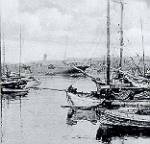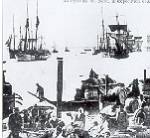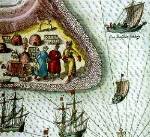
The harbour of Vardø
about 1900


The fish market in
Archangelsk


Kildin,
end of 16th century
|
The Pomor Trade
Long-lasting trade has existed between northern Norway, Lappland and the northeastern part of Russia for some time. The notion of the Pomor trade is limited in time and peculiar to these trading connections that traditionally were so close. When referring to this commerce, we are usually dealing with the trade in the North that started at the beginning of the 18th-century and lasted two-hundred years - until the 1917 Russian Revolution. This kind of trade spread across large parts of northern Norway's coastline. It materialized between those who lived here and the Russians who came from the coastal regions bordering on the White Sea. The Russians were thus those who were most active in trade via freighting and annual visits.
The word "Pomor" indicates something that is "by the sea" and is used as a designation for a northern seafarer, or a Russian who lives by the White Sea. Archangel is the Pomor capital, and today it is home to a Pomor university. The city was founded in 1584 as a center of trade for northeastern Russia. This trade, however, was run by the Scots, English and Dutch, and must not be confused with the Pomor trade.
The Pomor trade was based upon the bartering of fish products and grain. Flour and grain were brought to northern Norway by the Pomors. Rye flour - "Russian flour" - was the main commodity that was bartered for various kinds of fish, such as flounder, cod and salmon. Because the Russians also were interested in fur products, their trade had great significance for the Sami, as well. The trading between the Pomors and the northern Norwegian population was extensive, and this was particuarly the case during years of war, crop failure and the lack of necessary provisions from southern Norway. More than 300 Pomor ships visited the northern regions of Norway annually, during the 19th-century, when Russian trade reached its greatest extent. Nearly 2000 individuals sailed on these ships and visited the same places in northern Norway each year. And even a distinct Russo-Norwegian pidgin language, or what some might call the language of trade, developed between Norwegians and Russians.
Due to the mercantile policies of the united monarchy that Denmark-Norway conducted, the Pomor trade of the 18th-century was actually deemed to be illegal. Those who traded with the Russians were punished by wealthy merchants. These merchants denied common people their winter provisions. Towards the end of the 18th-century, however, the Russian trade was legalized. Monopolies now ceased to exist and, as of 1789, trade became unrestricted in Finnmark. From now on, Finnmark was to be supplied with grain and flour from the East. And the first northern cities were established as a result of these trade procedures. Vardø became the most important city. This is the Pomor capital of Norway. One distinction of the formentioned trade is that it was meant to be the exclusive right of town merchants in the new-found cities and of the self-styled rural barons. Direct bartering was permitted between the common people and the Pomors in 1796 - initially, for a limited period of time during a calendar year.
The Pomor trade hastened liberalistic ideology and free trade legislation in Denmark-Norway. This happened through the repeal of the so-called Finnmark monopoly. Finnmark became an attractive area to move to during the 19th-century as a consequence of trade with the Russians. This applied to both Norwegians and Finnish Kvens. Permission to barter more freely with the Pomor skippers was to also apply to inhabitants of greater land regions in northern Norway from 1839 onwards.
Because of the Russian Revolution, the suspension of the Pomor trade led to negative consequences for northern Norwegian commerce, and it severely affected the communities of the coastal Sami.

|



